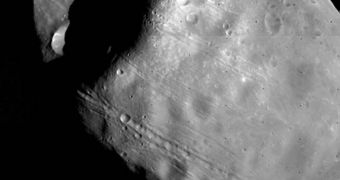Scientists from the Shanghai Astronomical Observatory (SAO) and Technical University Berlin (TUB) recently released a series of updated working models covering the properties of the gravitational field surrounding Mars' largest and closest moon, Phobos.
Like the second Martian moon, called Deimos, Phobos is extremely small – by comparison to our own Moon, for example – and irregular in shape. Astronomers cannot yet say for certain how these two objects were formed, or where.
One theory suggests that they coalesced from material placed in Martian orbit by past cosmic collision events. The debris that was thrown high above the surface eventually came together in these two moons. Another theory holds that they are asteroids captured by the Red Planet's gravitational pull.
The trouble with studying Phobos is that we have yet to dispatch a spacecraft to land on its surface. The Russian Federal Space Agency – which is apparently fascinated with Phobos in particular – tried to launch a sample-return mission to the Martian moon in late 2011, but the spacecraft failed.
Under the circumstances, figuring out how Phobos was formed, and what it's made up of, became an issue of compiling several low-resolution models of many of its properties. However, the quality of data that resulted from these models was very poor.
What the SAO/RUB team did was use data sent back by the European Space Agency's (ESA) Mars Express orbiter to augment the existing models. The spacecraft is now in an elliptical polar orbit, which enables it to conduct regular flybys of Phobos, and conduct measurements around the diminutive moon.
Details of how the new models were put together appear in the latest issue of the journal SCIENCE CHINA Physics, Mechanics & Astronomy, in a paper entitled “Working models for the gravitational field of Phobos.”
“As deep space exploration goes on, more and more missions aim to land on small bodies like Phobos. Therefore, it has become necessary to model the surface gravity of these bodies,” the researchers say.
“Due to the weak gravitation and relatively fast rotation, materials on the surface of these small bodies usually experiences a strange dynamical environment that is not always correlated to the topography,” they add.
The new models provide a gravitational map of Phobos, which should help scientists plan new missions for exploring this small world directly. Sending an orbiter or a lander to this Martian moon could finally reveal its makeup and origins, EurekAlert reports.

 14 DAY TRIAL //
14 DAY TRIAL //